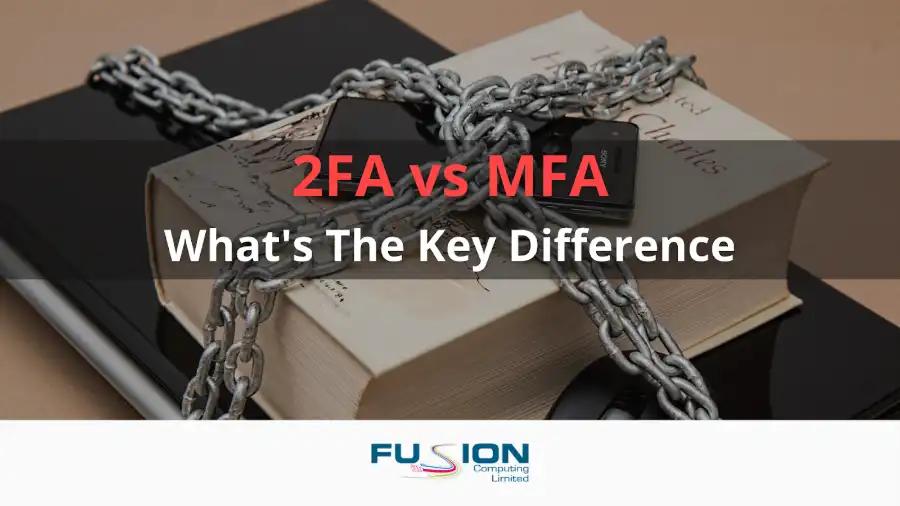MFA and 2FA, or to use the full terms, multi-factor authentication and two-factor authentication, are terms used in cyber security that are often used interchangeably yet have a subtle but important difference.
2FA vs. MFA: Are You Asking the Right Question?
First, let’s cover the definitions. Authentication is a security process that verifies a person who is trying to grant access to a system is who they claim to be. The person can prove it is them by providing a piece of evidence, allowing only authorized users access.
Factor, in this case, refers to the method of providing that evidence. So, if gaining access requires two-factor authentication (2FA), a user will need to verify their identity in exactly two different ways. Multi-factor authentication (MFA) requires two or more factors, which is why the terms can be used interchangeably. In fact, 2FA can be thought of as a subset of MFA.
The three basic factors of multi-factor authentication and 2FA are:
- Knowledge factor: something you know, like a password or secret answer
- Possession factor: something you have, like a mobile device or a security key
- Inherence factor: something unique to you, such as a fingerprint or eye retinal pattern
There’ll Be No Difference Between 2FA and MFA……if your users aren’t complying with access management practices. You need to build awareness and buy-in for security with internal teams. |
Multi-Factor Authentication and Two-Factor Authentication Are Becoming Ubiquitous
Most people have encountered some form of multi-factor authentication when using online accounts, and some find it frustrating. They might be asked to enter a password and then go through the additional step of, for example, entering a code that is sent by text message to their mobile phone.
While multi-factor authentication can be a nuisance in the moment, it’s important to know that single-factor authentication is no longer strong enough to keep your accounts safe from hackers.
In the past, most services used single-factor authentication in the form of a password. Once those passwords started getting lost or stolen online and hackers started using methods such as phishing and keylogging, it became clear that more was needed.
2FA and MFA Comparison
Simply by adding more authentication factors, MFA prevents unauthorized access by greatly reducing the likelihood that a hacker will have all the information they need to gain access to sensitive data.
Two factors are usually considered enough because it is highly unlikely that an attacker will know your password and be in possession of your mobile device, however sensitive services like online banking might require three factors just to add an extra level of caution. The chances of someone being able to obtain your fingerprint, for example, are extremely low.
Now that it’s widely agreed that MFA is required, attention has turned to how it is implemented and how it can be made as seamless and annoyance-free as possible for users.
There is a perception that MFA solutions are costly, hard to manage and so aggravating to customers that they will abandon your service. All of these can be true, but only if your MFA is poorly deployed.
There’s also a view that only companies of a certain size can benefit from MFA, and that too is a dangerous myth. The benefits are the same however big or small the business is. With that in mind, here are some things to consider when implementing your MFA solution:
1. Keep MFA and 2FA Simple for Your IT team
The surest way to make your IT team curse the day MFA was invented is to introduce a solution that is slow, cumbersome and causes them endless problems. Many businesses have already sworn off MFA for this reason, influenced by their IT teams that it’s causing more trouble than it’s worth.
MFA does not need to be frustrating. The best authentication solutions are easy to deploy and manage, don’t require new hardware or software to set up, and work within your existing IT environment.
They also allow for quick and simple problem resolution and keep you away from complex coding tasks.
2. Find the Balance Between Security and Efficiency
It will be difficult to convince your business colleagues to stick with MFA if it’s turning away customers and causing never-ending login issues. Therefore, it’s important to find the sweet spot between ensuring user accounts are secure and making them jump through hoops.
Consider choosing an MFA solution that remembers users for a certain amount of time after identity verification and choose intuitive, universal options like smartphone authentication.
| Protect Accounts and Endpoints Better: |
3. Make Sure Your Users Understand the Importance of MFA
Some services offer MFA but don’t require that users enable it. Fewer than 10% of Google accounts, for example, have two-factor authentication methods enabled, because the company doesn’t make users set it up. This is likely because they don’t fully understand its importance.
There are methods you can use to get users to think twice about their account security. For example, alerting them to rogue login attempts via email can persuade them to enable 2FA and MFA.
4. Roll It Out To All Users, Not Just Privileged Accounts
Some IT professionals see MFA as a tool to protect only privileged accounts, such as administrations. With the advances made in MFA in recent years, the technology is much more adaptable and user-friendly, so it’s just as easy to make it available to all users.
5. Ensure The Leadership Team Is On Board With MFA
MFA can be a hard sell. It costs money, it impedes users and it sounds complicated. If you do a good job of explaining why it’s needed, and stay away from the geek speak, even the most stubborn executive will have to concede that MFA is a necessary evil in today’s online world.
Ultimately, the leadership team needs to view what you are doing as a crucial enabler, rather than an optional distraction.
Two-Factor Authentication vs. Multi-Factor Authentication: Find the Right Option for Your Business
Fusion Computing is one of Toronto’s leading managed service providers and is experienced in helping businesses roll out simple and effective MFA solutions. Contact us today to learn more about MFA and 2FA and how they can keep your user’s account secure.




